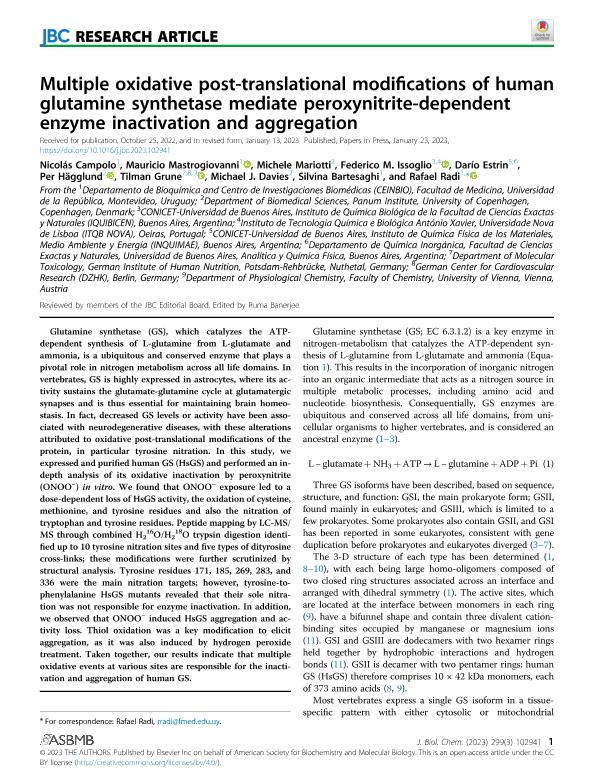Artículo
Multiple oxidative post-translational modifications of human glutamine synthetase mediate peroxynitrite-dependent enzyme inactivation and aggregation
Campolo, Nicolás; Mastrogiovanni, Mauricio; Mariotti, Michele; Issoglio, Federico Matías ; Estrin, Dario Ariel
; Estrin, Dario Ariel ; Hägglund, Per; Grune, Tilman; Davies, Michael J.; Bartesaghi, Silvina; Radi, Rafael
; Hägglund, Per; Grune, Tilman; Davies, Michael J.; Bartesaghi, Silvina; Radi, Rafael
 ; Estrin, Dario Ariel
; Estrin, Dario Ariel ; Hägglund, Per; Grune, Tilman; Davies, Michael J.; Bartesaghi, Silvina; Radi, Rafael
; Hägglund, Per; Grune, Tilman; Davies, Michael J.; Bartesaghi, Silvina; Radi, Rafael
Fecha de publicación:
03/2023
Editorial:
American Society for Biochemistry and Molecular Biology
Revista:
Journal of Biological Chemistry (online)
ISSN:
0021-9258
Idioma:
Inglés
Tipo de recurso:
Artículo publicado
Clasificación temática:
Resumen
Glutamine synthetase (GS), which catalyzes the ATP-dependent synthesis of L-glutamine from L-glutamate and ammonia, is a ubiquitous and conserved enzyme that plays a pivotal role in nitrogen metabolism across all life domains. In vertebrates, GS is highly expressed in astrocytes, where its activity sustains the glutamate-glutamine cycle at glutamatergic synapses and is thus essential for maintaining brain homeostasis. In fact, decreased GS levels or activity have been associated with neurodegenerative diseases, with these alterations attributed to oxidative post-translational modifications of the protein, in particular tyrosine nitration. In this study, we expressed and purified human GS (HsGS) and performed an in-depth analysis of its oxidative inactivation by peroxynitrite (ONOO−) in vitro. We found that ONOO− exposure led to a dose-dependent loss of HsGS activity, the oxidation of cysteine, methionine, and tyrosine residues and also the nitration of tryptophan and tyrosine residues. Peptide mapping by LC-MS/MS through combined H216O/H218O trypsin digestion identified up to 10 tyrosine nitration sites and five types of dityrosine cross-links; these modifications were further scrutinized by structural analysis. Tyrosine residues 171, 185, 269, 283, and 336 were the main nitration targets; however, tyrosine-to-phenylalanine HsGS mutants revealed that their sole nitration was not responsible for enzyme inactivation. In addition, we observed that ONOO− induced HsGS aggregation and activity loss. Thiol oxidation was a key modification to elicit aggregation, as it was also induced by hydrogen peroxide treatment. Taken together, our results indicate that multiple oxidative events at various sites are responsible for the inactivation and aggregation of human GS.
Archivos asociados
Licencia
Identificadores
Colecciones
Articulos(INQUIMAE)
Articulos de INST.D/QUIM FIS D/L MATERIALES MEDIOAMB Y ENERGIA
Articulos de INST.D/QUIM FIS D/L MATERIALES MEDIOAMB Y ENERGIA
Articulos(IQUIBICEN)
Articulos de INSTITUTO DE QUIMICA BIOLOGICA DE LA FACULTAD DE CS. EXACTAS Y NATURALES
Articulos de INSTITUTO DE QUIMICA BIOLOGICA DE LA FACULTAD DE CS. EXACTAS Y NATURALES
Citación
Campolo, Nicolás; Mastrogiovanni, Mauricio; Mariotti, Michele; Issoglio, Federico Matías; Estrin, Dario Ariel; et al.; Multiple oxidative post-translational modifications of human glutamine synthetase mediate peroxynitrite-dependent enzyme inactivation and aggregation; American Society for Biochemistry and Molecular Biology; Journal of Biological Chemistry (online); 299; 3; 3-2023; 1-22
Compartir
Altmétricas



